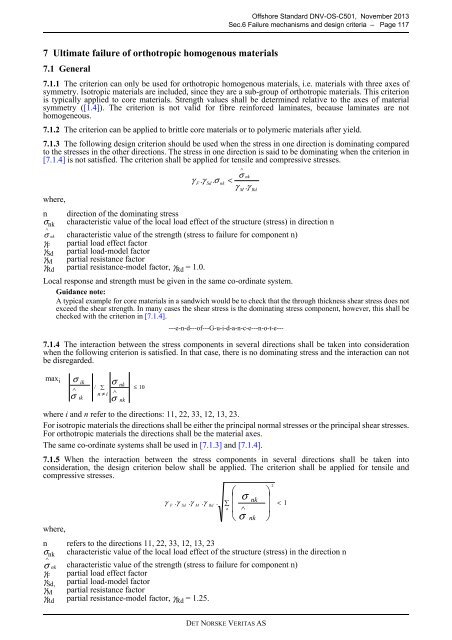OS-C501
Create successful ePaper yourself
Turn your PDF publications into a flip-book with our unique Google optimized e-Paper software.
Offshore Standard DNV-<strong>OS</strong>-<strong>C501</strong>, November 2013<br />
Sec.6 Failure mechanisms and design criteria – Page 117<br />
7 Ultimate failure of orthotropic homogenous materials<br />
7.1 General<br />
7.1.1 The criterion can only be used for orthotropic homogenous materials, i.e. materials with three axes of<br />
symmetry. Isotropic materials are included, since they are a sub-group of orthotropic materials. This criterion<br />
is typically applied to core materials. Strength values shall be determined relative to the axes of material<br />
symmetry ([1.4]). The criterion is not valid for fibre reinforced laminates, because laminates are not<br />
homogeneous.<br />
7.1.2 The criterion can be applied to brittle core materials or to polymeric materials after yield.<br />
7.1.3 The following design criterion should be used when the stress in one direction is dominating compared<br />
to the stresses in the other directions. The stress in one direction is said to be dominating when the criterion in<br />
[7.1.4] is not satisfied. The criterion shall be applied for tensile and compressive stresses.<br />
where,<br />
n<br />
σ nk<br />
∧<br />
direction of the dominating stress<br />
characteristic value of the local load effect of the structure (stress) in direction n<br />
σ nk characteristic value of the strength (stress to failure for component n)<br />
γ F partial load effect factor<br />
γ Sd partial load-model factor<br />
γ M partial resistance factor<br />
γ Rd partial resistance-model factor, γ Rd = 1.0.<br />
Local response and strength must be given in the same co-ordinate system.<br />
Guidance note:<br />
A typical example for core materials in a sandwich would be to check that the through thickness shear stress does not<br />
exceed the shear strength. In many cases the shear stress is the dominating stress component, however, this shall be<br />
checked with the criterion in [7.1.4].<br />
---e-n-d---of---G-u-i-d-a-n-c-e---n-o-t-e---<br />
7.1.4 The interaction between the stress components in several directions shall be taken into consideration<br />
when the following criterion is satisfied. In that case, there is no dominating stress and the interaction can not<br />
be disregarded.<br />
max i<br />
where i and n refer to the directions: 11, 22, 33, 12, 13, 23.<br />
For isotropic materials the directions shall be either the principal normal stresses or the principal shear stresses.<br />
For orthotropic materials the directions shall be the material axes.<br />
The same co-ordinate systems shall be used in [7.1.3] and [7.1.4].<br />
7.1.5 When the interaction between the stress components in several directions shall be taken into<br />
consideration, the design criterion below shall be applied. The criterion shall be applied for tensile and<br />
compressive stresses.<br />
where,<br />
n refers to the directions 11, 22, 33, 12, 13, 23<br />
characteristic value of the local load effect of the structure (stress) in the direction n<br />
σ nk<br />
∧<br />
σ<br />
∧<br />
σ<br />
ik<br />
ik<br />
σ<br />
/ ∑<br />
nk<br />
≤ 10<br />
n ≠ i<br />
∧<br />
σ nk<br />
γ . γ<br />
γ . γ . σ<br />
σ nk characteristic value of the strength (stress to failure for component n)<br />
γ F partial load effect factor<br />
γ Sd, partial load-model factor<br />
γ M partial resistance factor<br />
γ Rd partial resistance-model factor, γ Rd = 1.25.<br />
F<br />
Sd<br />
. γ<br />
F<br />
M<br />
. γ<br />
Sd<br />
Rd<br />
.<br />
nk<br />
∧<br />
σ nk<br />
<<br />
γ . γ<br />
∑<br />
n<br />
M<br />
⎛<br />
⎜ σ<br />
⎜ ∧<br />
⎝ σ<br />
Rd<br />
nk<br />
nk<br />
⎞<br />
⎟ ⎟ ⎠<br />
2<br />
< 1<br />
DET NORSKE VERITAS AS



